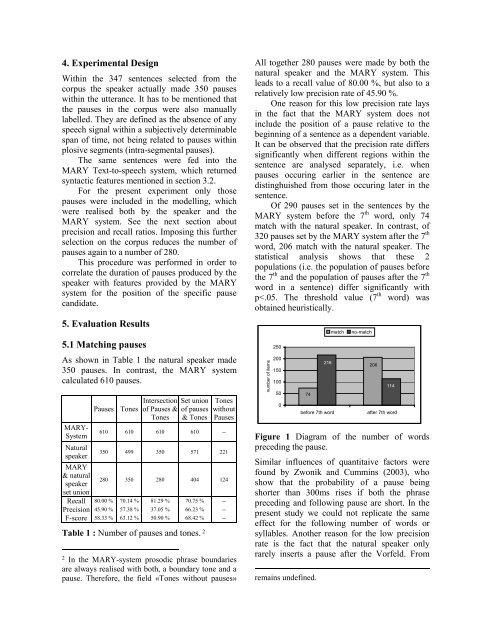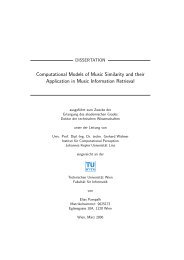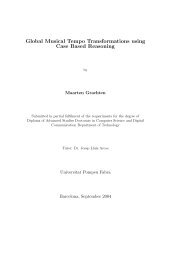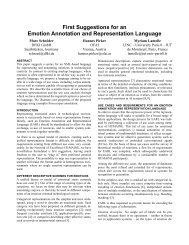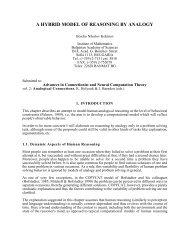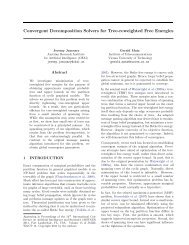Have a break! Modelling pauses in German Speech. - ResearchGate
Have a break! Modelling pauses in German Speech. - ResearchGate
Have a break! Modelling pauses in German Speech. - ResearchGate
Create successful ePaper yourself
Turn your PDF publications into a flip-book with our unique Google optimized e-Paper software.
4. Experimental Design<br />
With<strong>in</strong> the 347 sentences selected from the<br />
corpus the speaker actually made 350 <strong>pauses</strong><br />
with<strong>in</strong> the utterance. It has to be mentioned that<br />
the <strong>pauses</strong> <strong>in</strong> the corpus were also manually<br />
labelled. They are def<strong>in</strong>ed as the absence of any<br />
speech signal with<strong>in</strong> a subjectively determ<strong>in</strong>able<br />
span of time, not be<strong>in</strong>g related to <strong>pauses</strong> with<strong>in</strong><br />
plosive segments (<strong>in</strong>tra-segmental <strong>pauses</strong>).<br />
The same sentences were fed <strong>in</strong>to the<br />
MARY Text-to-speech system, which returned<br />
syntactic features mentioned <strong>in</strong> section 3.2.<br />
For the present experiment only those<br />
<strong>pauses</strong> were <strong>in</strong>cluded <strong>in</strong> the modell<strong>in</strong>g, which<br />
were realised both by the speaker and the<br />
MARY system. See the next section about<br />
precision and recall ratios. Impos<strong>in</strong>g this further<br />
selection on the corpus reduces the number of<br />
<strong>pauses</strong> aga<strong>in</strong> to a number of 280.<br />
This procedure was performed <strong>in</strong> order to<br />
correlate the duration of <strong>pauses</strong> produced by the<br />
speaker with features provided by the MARY<br />
system for the position of the specific pause<br />
candidate.<br />
5. Evaluation Results<br />
5.1 Match<strong>in</strong>g <strong>pauses</strong><br />
As shown <strong>in</strong> Table 1 the natural speaker made<br />
350 <strong>pauses</strong>. In contrast, the MARY system<br />
calculated 610 <strong>pauses</strong>.<br />
Pauses<br />
Tones<br />
Intersection Set union<br />
of Pauses & of <strong>pauses</strong><br />
Tones & Tones<br />
Tones<br />
without<br />
Pauses<br />
MARY-<br />
System<br />
610 610 610 610 --<br />
Natural<br />
speaker<br />
350 499 350 571 221<br />
MARY<br />
& natural<br />
speaker<br />
280 350 280 404 124<br />
set union<br />
Recall 80.00 % 70.14 % 81.29 % 70.75 % --<br />
Precision 45.90 % 57.38 % 37.05 % 66.23 % --<br />
F-score 58.33 % 63.12 % 50.90 % 68.42 % --<br />
Table 1 : Number of <strong>pauses</strong> and tones. 2<br />
2<br />
In the MARY-system prosodic phrase boundaries<br />
are always realised with both, a boundary tone and a<br />
pause. Therefore, the field «Tones without <strong>pauses</strong>»<br />
All together 280 <strong>pauses</strong> were made by both the<br />
natural speaker and the MARY system. This<br />
leads to a recall value of 80.00 %, but also to a<br />
relatively low precision rate of 45.90 %.<br />
One reason for this low precision rate lays<br />
<strong>in</strong> the fact that the MARY system does not<br />
<strong>in</strong>clude the position of a pause relative to the<br />
beg<strong>in</strong>n<strong>in</strong>g of a sentence as a dependent variable.<br />
It can be observed that the precision rate differs<br />
significantly when different regions with<strong>in</strong> the<br />
sentence are analysed separately, i.e. when<br />
<strong>pauses</strong> occur<strong>in</strong>g earlier <strong>in</strong> the sentence are<br />
dist<strong>in</strong>ghuished from those occur<strong>in</strong>g later <strong>in</strong> the<br />
sentence.<br />
Of 290 <strong>pauses</strong> set <strong>in</strong> the sentences by the<br />
MARY system before the 7 th word, only 74<br />
match with the natural speaker. In contrast, of<br />
320 <strong>pauses</strong> set by the MARY system after the 7 th<br />
word, 206 match with the natural speaker. The<br />
statistical analysis shows that these 2<br />
populations (i.e. the population of <strong>pauses</strong> before<br />
the 7 th and the population of <strong>pauses</strong> after the 7 th<br />
word <strong>in</strong> a sentence) differ significantly with<br />
p


